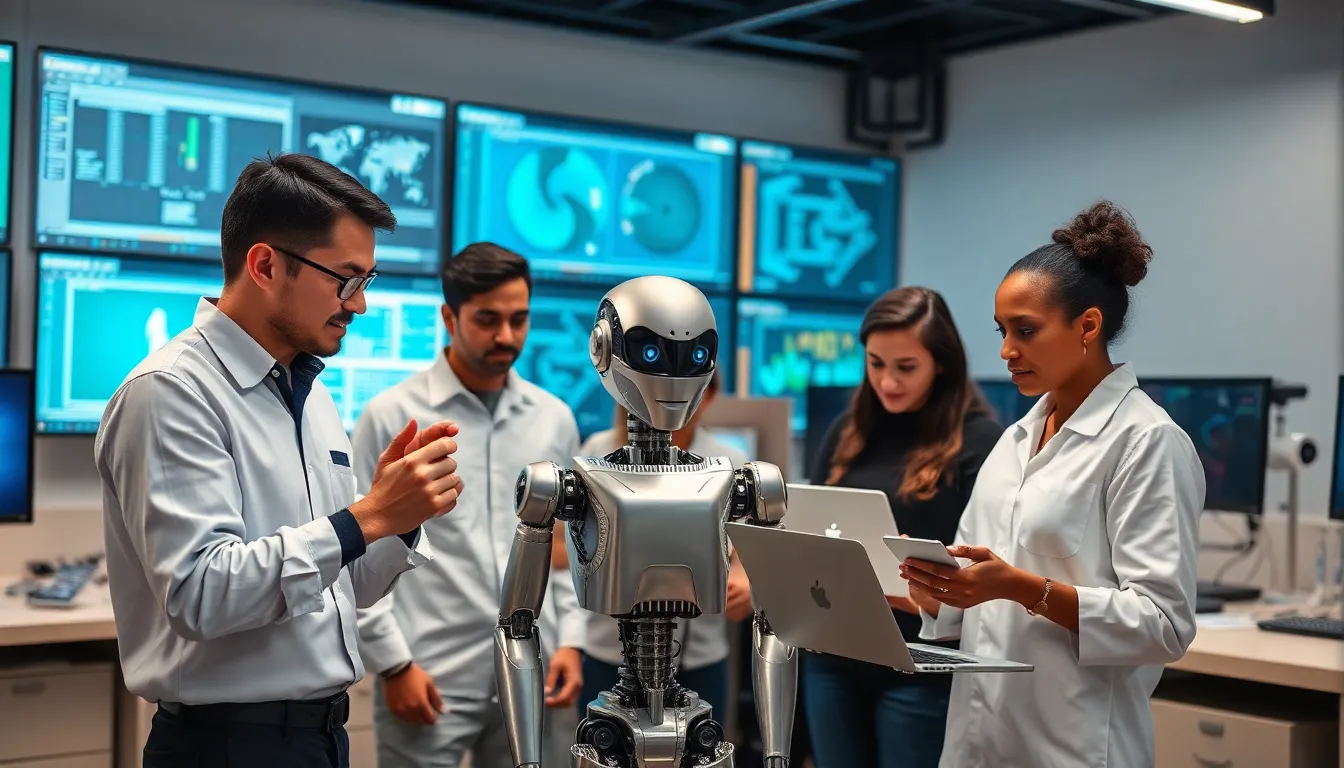Artificial intelligence isn’t just a buzzword tossed around in tech circles; it’s a game-changer that’s reshaping how we live, work, and even argue with our smart devices. Imagine a world where machines can learn, reason, and maybe even tell a joke or two—well, that’s the magic of AI. But before diving into the realm of sentient robots and self-driving cars, it’s crucial to understand the building blocks that make this technology tick.
Table of Contents
ToggleOverview of Artificial Intelligence
Artificial intelligence (AI) encompasses a range of technologies designed to mimic human intelligence. These technologies include machine learning, natural language processing, robotics, and computer vision. Each component plays a vital role in creating systems that can learn, adapt, and perform tasks typically requiring human intelligence.
Machine learning enables systems to analyze data and identify patterns without explicit programming. This technique drives many AI applications, including recommendation systems and predictive analytics. By utilizing large datasets, machine learning algorithms improve their accuracy over time.
Natural language processing focuses on understanding and generating human language. It allows machines to interpret text and speech, facilitating interactions between computers and users. Applications like chatbots and virtual assistants rely heavily on this technology to provide responsive communication.
Robotics combines AI with physical machines, enabling them to perform tasks autonomously. Robots equipped with AI can navigate environments, manipulate objects, and even learn new skills through experience. This capability finds applications in industries such as manufacturing and healthcare.
Computer vision involves enabling machines to interpret and understand visual information from the world. Image recognition and object detection are key areas where computer vision excels. Companies leverage this technology for quality control, surveillance, and autonomous navigation.
Understanding these components is crucial for grasping the full potential of AI. Each element contributes to creating intelligent systems capable of transforming various industries. As AI continues to evolve, its applications will expand and shape the future of technology further.
Key Components of Artificial Intelligence

Understanding key components of artificial intelligence reveals how they collectively enhance machine capabilities. The following elements play significant roles in the development and implementation of AI technologies.
Machine Learning
Machine learning focuses on enabling systems to learn from data. Through algorithms, these systems identify patterns and make predictions. An example includes recommendation systems used by e-commerce platforms. Users receive tailored suggestions based on their browsing and purchase history. Additionally, machine learning drives various applications such as predictive analytics in finance or healthcare, where it helps to forecast trends and optimize decision-making.
Natural Language Processing
Natural language processing is essential for enabling machines to understand human language. This technology facilitates seamless communication between users and AI systems, such as chatbots and virtual assistants. By processing vast amounts of text data, NLP allows machines to interpret context and respond appropriately. For instance, virtual assistants like Siri and Alexa can comprehend commands and answer queries effectively. This technology continually evolves, improving user experiences across various platforms.
Computer Vision
Computer vision empowers machines to interpret and analyze visual information. By using sophisticated algorithms, this technology detects objects, recognizes faces, and even identifies anomalies in images. Applications span numerous fields, including autonomous vehicles, which rely on computer vision for navigation. Quality control in manufacturing also benefits, as machines can inspect products for defects. As computer vision advances, its applications continue to expand, driving innovations in security, healthcare, and more.
Robotics
Robotics combines AI with physical machines capable of performing tasks autonomously. This integration enhances efficiency across industries, including manufacturing and healthcare. For example, robotic arms in factories streamline assembly lines, while surgical robots assist surgeons in precision procedures. These machines frequently incorporate machine learning and computer vision, enabling them to adapt to their environments. As robotics technology progresses, its presence in everyday life becomes increasingly prominent.
Additional Technologies Supporting AI
Several additional technologies complement the core components of artificial intelligence, enhancing its capabilities and broadening its applications.
Neural Networks
Neural networks play a crucial role in AI, mimicking the human brain’s structure. These systems consist of interconnected nodes, or neurons, that process data in layers. Each layer extracts features or patterns, enabling the neural network to learn from large datasets. Applications include image and speech recognition, where neural networks excel in identifying patterns that traditional algorithms might miss. Notably, deep learning, a subset of neural networks, enables sophisticated tasks such as natural language understanding and autonomous driving.
Expert Systems
Expert systems utilize knowledge-based approaches to solve complex problems within specific domains. These AI systems replicate the decision-making abilities of human experts by leveraging a set of rules and facts. Knowledge from various fields is often encoded, allowing the system to provide recommendations or solutions. Medical diagnosis and financial forecasting serve as prime examples where expert systems offer valuable insights. Despite their limitations in adapting to new information, expert systems remain significant in fields requiring high levels of expertise.
Real-World Applications of AI Components
Artificial intelligence components play crucial roles across various industries. Machine learning serves as the backbone for predictive analytics, which businesses use to tailor marketing strategies based on consumer behavior. For example, streaming services like Netflix analyze viewing habits to suggest personalized content.
Natural language processing powers virtual assistants such as Amazon’s Alexa and Apple’s Siri, enhancing user experience through voice recognition. Users can easily control devices or find information simply by speaking, making interactions more intuitive. Beyond personal use, chatbots in customer service streamline responses, reducing wait times and improving customer satisfaction.
In manufacturing, robotics enhances productivity by automating repetitive tasks. Collaborative robots, or cobots, work alongside human operators to optimize workflow and safety. Factories have reported increases in efficiency and a decrease in error rates since implementing robotic systems.
Computer vision applications extend to various fields, including healthcare, where image analysis aids in early disease detection. Radiologists utilize advanced imaging analyses to identify anomalies in scans accurately. Automotive industries also benefit from computer vision—self-driving cars rely on this technology to navigate and interpret their environments effectively.
Neural networks are instrumental in image and speech recognition tasks, powering innovations from facial recognition systems to smartphone interfaces. Deep learning’s advanced capabilities further permit real-time analysis, enabling applications in finance for fraud detection and portfolio management.
Expert systems remain integral in specialized domains, providing decision-making assistance in areas like medical diagnostics. Medical professionals often rely on these systems for insights into complex cases, demonstrating how AI enhances human expertise.
Overall, the integration of these AI components across industries showcases their transformative impact on everyday activities and operations.
Understanding the components of artificial intelligence is essential for grasping its transformative potential. Each element plays a critical role in enhancing machine capabilities and driving innovation across various sectors. From machine learning’s data-driven insights to natural language processing’s seamless communication, these technologies are reshaping how people interact with machines.
As AI continues to evolve, the integration of robotics and computer vision will further expand its applications. This evolution will not only improve efficiency but also open new avenues for creativity and problem-solving. Embracing these advancements can lead to significant benefits, making it crucial for individuals and businesses to stay informed about the ever-changing landscape of AI.




